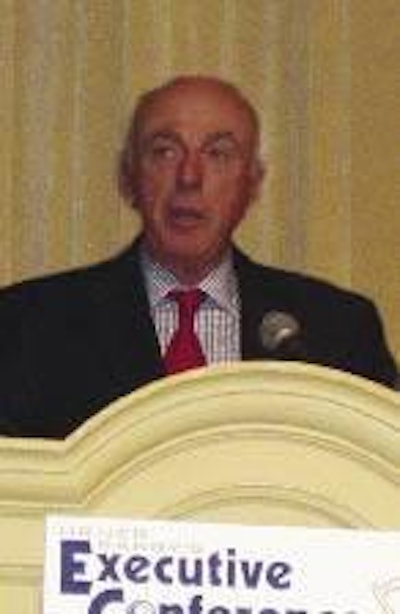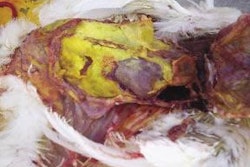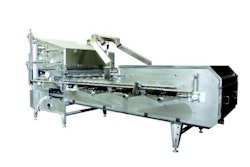
The theme of the 30th annual conference hosted by Urner Barry at the Bellagio Hotel in Las Vegas was “Charting the Course.”
The first speaker was Joel Johnson, Chairman of the Board of Hormel Foods. He brought many interesting statistics to the meeting concerning population and aging trends in the U.S. markets. An interesting statistic is that Americans are working about six weeks more per year than 20 years ago. Mr. Johnson also discussed the growth of meat consumption, primarily due to chicken, not only in the U.S., but worldwide. Development of new products by food manufacturers and processors such as Hormel is taking place because of the changing trends in eating and meal preparation by the consumer. Meals eaten in restaurants have decreased by some 13%, but meals purchased at restaurants and taken home to eat have increased by 24%. In addition, the numbers of smaller supermarkets are shrinking, being replaced by giant supercenters. In today’s market, the need is for value-added food products that are quicker and more convenient. Basically, success in manufacturing food is keeping up with what the consumer wants and by providing it to them in a timely and safe manner.
The featured speaker at the 30th year conference was Ari Fleischer, former Press Secretary of the Bush Administration in its early years. Mr. Fleischer provided excellent insight into the politics and decisions that followed such historic events as 9/11 and the conflicts in Afghanistan and Iraq.
The highlight of Monday evening’s events was the annual banquet with its presentation of the Eggman of the Year award. This year’s recipient was Lou Raffel, retiring President of the American Egg Board (AEB). Lou was honored by Urner Barry for his 30 years of service to the egg industry with AEB and their continuing efforts with the promotion of eggs.
Alan Andrews, Director of Marketing for Pactiv Corporation, spoke next in an egg industry breakout session. His topic was, “The Changing Retail Dairy Case and Its Effect on Shell Eggs and Egg Products Sales.” Mr. Andrews’ presentation consisted of a wealth of information through graphs, charts and tables depicting current trends and how they affect the egg industry. Trends were shown that reflected product sales, changing population, 20-year eating trends, shopping changes, brown and specialty eggs sales, etc. The audience, consisting of mainly egg producers and processors, saw that the population of the U.S. is now at 296 million people, consists of many ethnic groups, and baby boomers are making a big difference in eating habits.
Statistics were given on many trends such as the top ten items ordered at fast-food restaurants. Egg items were far down on the list. Big changes have occurred from 1985 through 2005 in eating habits. Today’s menu is not as healthy, and carbonated soft drinks now lead the pack at lunch and dinner. Trends show that the food manufacturers know what the consumer will buy, and eggs are not high on the list.
About 25% of the population is currently on a diet. People are looking at the Nutritional Fact Sheet that is on food labels to find additives and other harmful ingredients. It has been proven that people who are on diets eat more eggs. Why are people not eating more eggs? We need to continue a vigorous educational program to the public on the nutritional value of eggs. Some trends for egg consumption show increased sales of brown and specialty eggs as well as larger packages such as 18 and 30 count.
Andrews also presented many statistics on egg sales and profitability. Peak volume of egg sales are still Christmas and Easter; however, there are fewer consumer trips to the store because of the supercenter-type stores that actually lower egg sales. Of special interest were charts showing that profitability is affected at the retail level when egg sales are up. In summary, it is obvious that keeping informed of trends and market changes is an all-important factor in the success of the egg business.
Jim Sumner, President of the USA Poultry and Egg Export Council (USAPEEC), spoke next to a joint session of the UB attendees. He gave an overview of the USAPEEC operations and reported very positive results for the past year in exporting egg and poultry products. Total sales were approaching $3 billion, with about $1 billion of those in egg and egg products. Statistics show that turkey production and consumption is up considerably worldwide, and exports of these products are up dramatically since 1990. Eggs have steadily been improving, especially egg products. Main markets for export shell eggs and egg products are Canada, Japan, Mexico, Hong Kong, Cuba and Korea.
Mr. Sumner discussed the worldwide effect on the poultry industry from Avian Influenza (AI). Some demand in Asia is increasing for eggs due to AI. The industry should be focusing on safe handling, providing education on dealing with AI and assume that no one is perfect in addressing the issue. This work is supported by the International Poultry Council (IPC) of which Mr. Sumner is President. A new ad sponsored by the IPC states that “Poultry is Safe, Just Cook It”. He also had many charts and graphs pointing out the potential problems that AI could create worldwide in a worst-case scenario. It is hoped that the disease will not become a major problem, but the world should prepare for the worst.
The next speaker was Joel Naroff of Naroff Economic Advisors, speaking on the economic impact of AI. The bottom line is that there will probably be limited economic consequences unless there is human-to-human transmission. In the U.S., even a mild pandemic could result in 100,000 deaths. A severe pandemic could take up to 1 million lives. The worst-case scenario would be great labor-related loss, medical services strained, travel curtailed and a general business productivity and confidence decline. It conceivably could take a year or more to see signs of recovery under the most severe conditions. Dr. Naroff has exceptional credentials and has been advising corporations on economic development in a variety of industries for many years. He is a tenured professor of economics at the University of Massachusetts in Amherst.
Mr. William Lapp from Advanced Economic Solutions reported to the breakout egg industry group. Mr. Lapp has surveyed the pricing of eggs from a scientific standpoint and through his research has come up with some suggestions that could be implemented to help determine a better result. His analysis included detailed numbers on the egg industry such as past consumption, supply and pricing patterns. Although the 2003 and 2004 markets for eggs were somewhat stable, there are record numbers of layers today. In addition, feed costs are expected to rise. The industry production remains excessive and fragmented, according to Mr. Lapp. The top 10 producers in this country are producing 40% of the total eggs and production is, in fact, shifting to the Midwest. All of this with the demand for eggs remaining flat and more consolidations are taking place. Mr. Lapp said that today’s pricing system is doing the job reasonably well. The combination of pricing procedures from Egg Clearing House and Urner Barry are critical. Adjusting to market changes is all-important to the egg industry.
Mr. Lapp continued by stating some of the basic wants of the retailer, such as discounts, enough production to meet their needs and less price volatility. He stated that retailers are not particularly concerned with how high or low egg prices are. Retail demand does not seem to be that responsive to changes in prices. From a producer’s standpoint they want a transparent price discovery system, less volatility and the ability to conveniently buy and sell from other producers; as well as better understanding of how discount prices are established. In addition, the producer needs a clearer mechanism to adjust and incorporate processing and transportation (PCT) into market pricing. There are several natural obstacles facing the delivery and pricing systems for eggs. Eggs need to find homes within days of production. Retailers want fresh eggs. Egg demand is seasonal. Mr. Lapp pointed out that ECI and UB are very valuable to the table egg industry by providing a consistent, independent benchmark for both producers and retailers. By working with UEP and others, Urner Barry provides industry leadership.
Through his analysis of the situation, Mr. Lapp made several recommendations to Urner Barry:
1. Provide greater transparency of price calculations.
2. Consider increased staffing at Urner Barry in egg pricing activities.
3. Outsource some or all of the PCT survey and PCT Cost Adjustment Factor. He said the industry does not believe the factors set by UB.
4. Meet regularly with retailers/marketers to consider alternative means of pricing eggs.
Mr. Lapp commented that the U.S. Table Egg Industry Study is not yet completed.
Lou Raffel, AEB President, made some brief comments to the assembled egg producers. AI is currently the chief concern for the industry. AEB is addressing the issue using their new public relations firm Edelman to educate and respond to the media coverage without creating negative coverage. Their motto is: “Hope for the best and prepare for the worst.” AEB is continuing their work with government agencies as well as coordinating efforts with the National Chicken Council and National Turkey Federation to provide information on AI through the website: avianinfluenzainfo.com. In addition, AEB is preparing an AI crisis manual, preparedness workshops, Egg Nutrition Center weekly updates and crisis advertising. Should a crisis hit, all promotional advertising now planned will be changed to AI information ads.
Rick Brown and Randy Pesciotta completed the day’s meetings with their Urner Barry Reporter’s Roundtable. Opening remarks by Mr. Brown indicated that this is the largest egg layer flock in the nation’s history. This creates a lower price for all categories of eggs, and adding to the problem, each bird is genetically improved to produce more eggs. Among the many topics discussed by Brown and Pesciotta were the several categories of egg product quotes that they will discontinue. They stated that last year’s hurricane season affected freight costs. Regarding the consumption of eggs, it seems the Easter market is flat and that the coloring concept has gone away. The really good news is the export market for both shell eggs and egg products is up and should continue to go up.
Regarding the Bill Lapp review reported earlier, Brown and Pesciotta reviewed and addressed the recommendations:
1. Transparency. They will create a cheat sheet to explain how prices are arrived at each day. Provide detailed history of previous year’s data. Form an UB advisory committee to recommend adjustments to price calculations. All of this will require information from the industry.
2. Staff. UB will consider increased staffing as well as the number of participants contacted.
3. Outsource PCT. This creates the greatest amount of criticism and controversy among producers. Much hard work has been squandered and the industry does not believe the results.
4. Meet with retailers/marketers. They will consider forming an ad hoc committee to review alternative means, with the goal being less volatility. Producers are encouraged to give Urner Barry a call at any time and they will send information.
There are basically no good answers at this time for the bad egg prices – except to reduce the overall flock size.


















